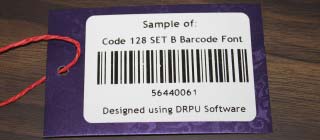Different Types of Barcodes Used in Banking Industry
Posted By: Technogeek | Last Updated On:
Types of Barcodes Used in Banking Industries
Barcodes are widely used in the banking industry to improve operational efficiency, reduce errors, and enhance customer experience. The most commonly used types of barcodes in the banking industry are:
-
MICR (Magnetic Ink Character Recognition):
MICR is a type of barcode that is printed at the bottom of checks and other financial documents. It contains important information such as the bank routing number, account number, and check number. MICR codes are read using magnetic scanners that can quickly and accurately read the characters and numbers.
-
QR (Quick Response) Code:

QR codes are used in the banking industry to provide customers with quick and easy access to account information, bank services, and other resources. For example, a QR code can be printed on a bank statement or promotional material, and customers can scan the code using their smartphones to access online banking, make transactions, and more.
-
Data Matrix:
Data Matrix barcodes are used in the banking industry to track and manage inventory, as well as to store important information such as customer account details, loan applications, and other financial documents. Data Matrix codes can be printed on documents or products, and can be quickly scanned using a barcode scanner or mobile device.
-
Code 128:

Code 128 barcodes are used in the banking industry to track and manage assets such as computers, servers, and other equipment. These barcodes can be printed on asset tags or labels, and can be scanned using a barcode scanner to quickly access important asset information such as location, ownership, and maintenance history.
Overall, barcodes play an important role in the banking industry by providing a fast, efficient, and reliable way to manage financial transactions and customer data. By using barcodes, banks and financial institutions can improve their operations, reduce errors, and provide a better customer experience.
Uses of Barcode in Banking Industry
Barcodes are used in the banking industry for a variety of purposes, including:
-
Cheque Processing
Barcodes are printed on cheques to help banks process them more quickly and accurately. The barcode contains important information about the cheque and cheque processing, including the account number, cheque number, and amount.
-
ATM Transactions
Barcodes are sometimes used in ATM transactions to help identify the account holder and the transaction being performed.Barcode may be printed on a withdrawal slip that the customer can scan at the ATM instead of entering their account and transaction information manually.
-
Document Management
Barcodes can be used to help banks manage documents more efficiently. For example, barcodes can be printed on loan applications, account opening documents, and other paperwork to help banks keep track of them and retrieve them quickly when needed.
-
Asset Tracking
Barcodes can be used to track and manage bank assets, such as computers, printers, and other equipment. By scanning a barcode, bank employees can quickly identify the asset and track its location, maintenance history, and other important information.
Overall, barcodes are an important tool for banks to improve efficiency, accuracy, and customer service. They help banks process transactions more quickly and accurately, manage documents more efficiently, and track assets more effectively.
Future of Barcode Technology in Banking Industry
The Future of Barcode Technology in the Banking Industry looks promising, with continued advancements that will improve security, processing times, customer service, automation, and record-keeping. These innovations will help to improve banking operations, making it faster, more efficient, and more secure for customers and financial institutions alike.
The future of barcode technology in the banking industry is expected to see significant growth and development, with several advancements that will improve banking operations in several ways:
- Enhanced security: Barcode technology can be used to enhance security in the banking industry, making it more difficult for fraudsters to duplicate or manipulate checks or other financial documents.
- Faster and more efficient processing: The use of barcode technology in the banking industry can help speed up and streamline the processing of financial transactions, reducing the time and resources required for manual input and processing.
- Increased automation: The use of barcode technology can help increase automation in the banking industry, reducing the need for manual input and improving overall efficiency.
- Improved customer service: Barcode technology can be integrated with customer service platforms, enabling customers to access real-time information about their accounts and transactions.
- Better record-keeping: Barcode technology can be used to create digital records of financial transactions, making it easier to track and analyze banking data for compliance or reporting purposes.
You may also like: What types of barcodes are used in the banking industry, and what are they used for?